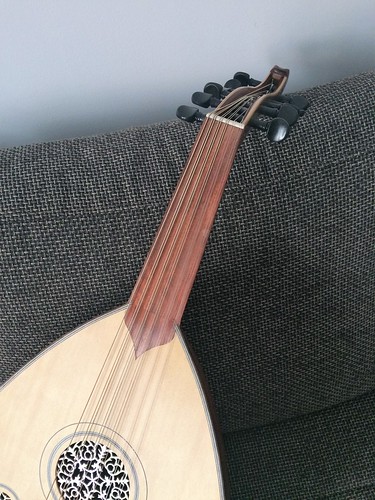arsene
Oud Junkie
    
Posts: 366
Registered: 5-19-2007
Location: Rotterdam, NL
Member Is Offline
|
|
Pau Ferro for fingerboards
Hello all,
Those among you who also play guitar, may be aware of the increased use of alternative (sustainable) woods and materials in guitar building in recent
years.
Some acoustic guitar makers like Martin have even moved to synthetic materials like Richlite and Micarta for their fingerboards -- both materials are
intended to mimic ebony. I have played a micarta equipped guitar, and I actually liked the playability, but it had a rather synthetic smell to it!
Perhaps most notably, Fender has made a massive move to Pau Ferro fingerboards for a lot of their models, due to the limitatoins put on Rosewood by
the CITES agreement.
I own a Fender Stratocaster with a Pau Ferro fretboard, and I must admit I am completely sold. I had my reservations before, knowing and loving
rosewood a lot, but the playability is just superb, the sound is a little snappier than rosewood but not quite like maple, and it also looks fantastic
(something I only appreciated once seeing it in real life).
Here is a photo of that guitar (look at the nice grain in the PF wood):
 IMG_1356 IMG_1356
In better light:
 IMG_2492 IMG_2492
As far as I know, there is no one using PF for oud fingerboards. Is this just because (the oud insdustry largely being in countries outside of CITES,
I should think) ebony is still preferred / easily available and PF still a relatively unknown wood?
According to most, Pau Ferro lies mid-way between Ebony and Rosewood tonally speaking. A tinge brighter (but not as maple), with the same depth and
warmth. Playing, it feels very much like Ebony. On guitars, I prefer the feel of PF now much more than Maple or Rosewood.
Come to think of it, I've never seen a Turkish oud with a Rosewood fingerboard either, except the Bubinga-equipped entry level models by Sandi (of
which I now have one, it is actually rather nice. Just looks weird if you're used to black colored boards).
The Sandi bubinga fingerboard:
 IMG_2491 IMG_2491
So, what are your thoughts? Would Pau Ferro be a good idea to explore as fingerboard material? It would certainly introduce new options, retain that
smooth feel of Ebony, and in my opinion, it is visually pleasing.
Even more boldly, and keeping prices down, what about materials such as Micarta (synthetic composite) like Martin is using? It keeps the dark look of
ebony, it largely feels the same and is virtually indestructible to boot.
Perhaps an idea for new generation oud builders?
|
|
|
Brian Prunka
Oud Junkie
    
Posts: 2916
Registered: 1-30-2004
Location: Brooklyn, NY
Member Is Offline
Mood: Stringish
|
|
The primary consideration on a fretless instrument is the hardness of the material.
On a fretted guitar, you aren't really playing directly on the fingerboard and wear is not particularly a concern.
Ebony is very hard. Most rosewood is also very hard, though not quite as hard as ebony. Pau Ferro seems to be somewhat (or substantially) less hard
than most rosewood, though still harder than maple.
My concern with using it on ouds is the the fingerboard might develop unacceptable wear, which is a significant cause of buzzing and other tonal
defects. It might be worth a try in some less-expensive ouds, but certainly in a higher-end instrument I'd consider it an unacceptably risky
experiment and stick to ebony.
|
|
|
Jason
Oud Junkie
    
Posts: 733
Registered: 9-17-2005
Location: Louisville, KY
Member Is Offline
Mood: Loving my oud
|
|
I don't think pau ferro would work well on a fretless instrument due to it's lack of hardness. I had a cheap oud with a wenge fingerboard that was
kind of interesting but not something I would desire on an instrument I would play seriously. Still, I see no real reason to use anything other than
ebony. I haven't come across any fretless instruments with it but many people speak highly of richlite as an alternative to ebony.
|
|
|
Brian Prunka
Oud Junkie
    
Posts: 2916
Registered: 1-30-2004
Location: Brooklyn, NY
Member Is Offline
Mood: Stringish
|
|
Mohamed Fadel used bakelite (phenolic resin) for fingerboards, it is actually a great material.
|
|
|
arsene
Oud Junkie
    
Posts: 366
Registered: 5-19-2007
Location: Rotterdam, NL
Member Is Offline
|
|
Re. Pau Ferro's hardness:
I was under the impression that the Pau Ferro that Fender uses (L. Ferrea) has a Janka hardness close to 3000, not too far off from Ebony.
There are a number of woods called Pau Ferro, including Machaerium spp. that indeed seem to have a lower hardness of 1960. The fretboard Pau Ferro was
even heralded as being similar to Ebony in hardness and feel. I'm not 100% sure of this though as the internet gives conflicting information.
|
|
|
|